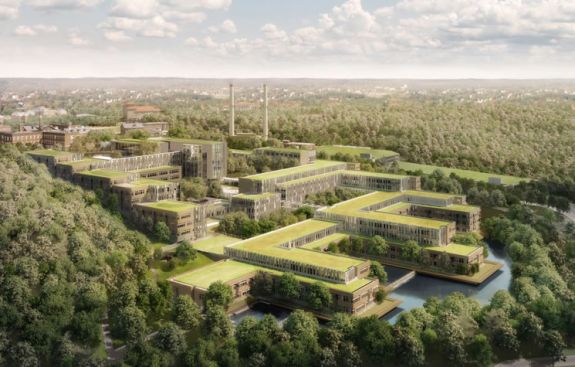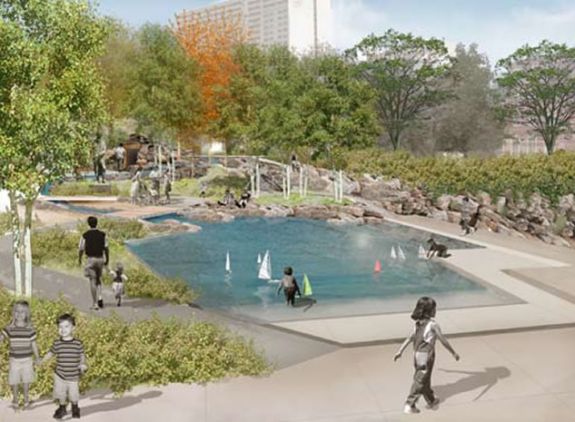Excerpted from the American Society of Landscape Architects Site
The Profession in Practice
Landscape architecture in the 1990s cannot be described in a few simple terms. The scope of the profession is too broad and the projects too varied.
A variety of often interwoven specializations exist within the profession, including the following: Landscape Design, the historical core of the profession, is concerned with detailed outdoor space design for residential, commercial, industrial, institutional, and public spaces. It involves the treatment of a site as art, the balance of hard and soft surfaces in outdoor and indoor spaces, the selection of construction and plant materials, infrastructure such as irrigation, and the preparation of detailed construction plans and documents.
 St Elizabeths Landscape Integration Plan, Washington DCSite Planning focuses on the physical design and arrangement of built and natural elements of a land parcel. A site planning project can involve designing the land for a single house, an office park or shopping center, or an entire residential community. More specifically, site design involves the orderly, efficient, aesthetic and ecologically sensitive integration of man-made objects with a site’s natural features including topography, vegetation, drainage, water, wildlife and climate. Sensitive design produces development that minimizes both environmental impacts and project costs, and adds value to a site.
St Elizabeths Landscape Integration Plan, Washington DCSite Planning focuses on the physical design and arrangement of built and natural elements of a land parcel. A site planning project can involve designing the land for a single house, an office park or shopping center, or an entire residential community. More specifically, site design involves the orderly, efficient, aesthetic and ecologically sensitive integration of man-made objects with a site’s natural features including topography, vegetation, drainage, water, wildlife and climate. Sensitive design produces development that minimizes both environmental impacts and project costs, and adds value to a site.
Urban/Town Planning deals with designing and planning cities and towns. Urban planners use zoning techniques and regulations, master plans, conceptual plans, land-use studies and other methods to set the layout and organization of urban areas. This field also involves “urban design” _ the development of mostly open, public spaces, such as plazas and streetscapes.
Regional Landscape Planning has emerged as a major area of practice for many landscape architects with the rise of the public’s environmental awareness in the past thirty years. It merges landscape architecture with environmental planning. In this field, landscape architects deal with the full spectrum of planning and managing land and water, including natural resource surveys, preparation of environmental impact statements, visual analysis, landscape reclamation and coastal zone management.
 Sister Cities Park, Philadelphia, PAPark and Recreation Planning involves creating or redesigning parks and recreational areas in cities, suburban and rural areas. Landscape architects also develop plans for huge natural areas as part of national park, forest, and wildlife refuge systems.
Sister Cities Park, Philadelphia, PAPark and Recreation Planning involves creating or redesigning parks and recreational areas in cities, suburban and rural areas. Landscape architects also develop plans for huge natural areas as part of national park, forest, and wildlife refuge systems.
Land Development Planning can be on large-scale, multi-acre parcels of undeveloped land and smaller scale sites in urban, rural and historic areas. As such, it provides a bridge between policy planning and individual development projects. Landscape architects working in this area require a knowledge of real estate economics and development regulation processes, as well as an understanding of the physical constraints of developing and working with the land. The challenge is to integrate economic factors with good design and thus create quality environments. Due to this blending of expertise, landscape architects are often selected to head multi-disciplinary design teams.
Ecological Planning and Design studies the interaction between people and the natural environment. It is concerned with interpretation, analysis, and formulation of design policies, guidelines and plans to ensure the quality of the environment. Heavily landscape architect and planner Ian McHarg, this specialization includes, but is not limited to, analytical evaluations of the land and focuses on the suitability of a site for development. It requires specific knowledge of environmental laws such as the Clean Water Act, the Safe Drinking Water Act, Federal wetlands regulations, etc. This specialization also encompasses highway design and planning.
Historic Preservation and Reclamation of sites such as parks, gardens, grounds, waterfronts, and wetlands involves increasing numbers of landscape architects as growing populations lead to additional development. This field may involve preservation or maintenance of a site in relatively static condition, conservation of a site as part of a larger area of historic importance, restoration of a site to a given date or quality, and renovation of a site for ongoing or new use. Landscape architects often participate from the research through the actual restoration stage.
Social and Behavioral Aspects of Landscape Design focuses on the human dimension of design, such as designing for the special needs of the elderly or the disabled. This field requires advanced training in social sciences, such as behavioral psychology, sociology, anthropology and economics. Areas of study include design evaluation of existing environments, environmental perceptions, and effects of environments on people.
